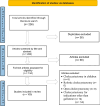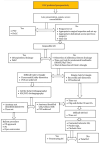The difficult laparoscopic cholecystectomy: a narrative review
- PMID: 40221716
- PMCID: PMC11992859
- DOI: 10.1186/s12893-025-02847-3
The difficult laparoscopic cholecystectomy: a narrative review
Abstract
Background/purpose: Laparoscopic cholecystectomy is one of the most commonly performed general surgical procedures. Difficult laparoscopic cholecystectomy is associated with increased operative time, hospital stay, complication rates, open conversion, treatment costs, and mortality. This study aimed to provide a comprehensive literature review on difficult laparoscopic cholecystectomy.
Methods: A literature search was conducted for articles published in English up to June 2024 using common databases including PubMed/MIDLINE, Web of Science, Google Scholar, and ScienceDirect. Keywords included "safe laparoscopic cholecystectomy", "difficult laparoscopic cholecystectomy", "acute cholecystitis", "prevention of bile duct injuries", "intraoperative cholangiography," "bailout procedure," and "subtotal cholecystectomy". Only clinical trials, systematic reviews/meta-analyses, and review articles were included. Studies involving children, robotic cholecystectomy, single incision laparoscopic cholecystectomy, open cholecystectomy, and cholecystectomy for indications other than gallstone disease were excluded.
Results/discussion: Emergency laparoscopic cholecystectomy for acute cholecystitis is ideally performed within 72 h of symptom onset, with a maximum window of 7-10 days. Intraoperative cholangiography can help clarify unclear biliary anatomy and detect bile duct injuries. In the "impossible gallbladder", laparoscopic cholecystostomy or gallbladder aspiration may be considered. When dissection of Calot's triangle is deemed hazardous or impossible, the fundus-first approach allows for completion of the procedure with either total cholecystectomy or subtotal cholecystectomy. Subtotal cholecystectomy is effective in preventing bile duct injuries, can be performed laparoscopically, and is currently the best available bailout approach for difficult laparoscopic cholecystectomy.
Conclusion: Difficult laparoscopic cholecystectomy is a common clinical scenario that requires a judicious approach by experienced surgeons in appropriate settings. When difficult laparoscopic cholecystectomy is encountered, various bailout strategies are available. Currently, subtotal cholecystectomy is likely the most effective bailout approach.
Keywords: Acute cholecystitis; Bailout procedure; Bile duct injuries; Difficult laparoscopic cholecystectomy; Intraoperative cholangiography; Safe laparoscopic cholecystectomy; Subtotal cholecystectomy.
© 2025. The Author(s).
Conflict of interest statement
Declarations. Ethics approval and consent to participate: not applicable. Consent for publication: not applicable. Competing interests: The authors declare no competing interests.
Figures


Similar articles
-
Bailout Surgery for Difficult Gallbladders: Surgical Approach and Outcomes.Am Surg. 2024 Jun;90(6):1324-1329. doi: 10.1177/00031348241227186. Epub 2024 Jan 23. Am Surg. 2024. PMID: 38259239
-
A comparison of outcomes including bile duct injury of subtotal cholecystectomy versus open total cholecystectomy as bailout procedures for severe cholecystitis: A multicenter real-world study.Surgery. 2024 Sep;176(3):605-613. doi: 10.1016/j.surg.2024.03.057. Epub 2024 May 22. Surgery. 2024. PMID: 38777659
-
A systematic review on laparoscopic subtotal cholecystectomy for difficult gallbladders: a lifesaving bailout or an incomplete operation?Ann R Coll Surg Engl. 2024 Mar;106(3):205-212. doi: 10.1308/rcsann.2023.0008. Epub 2023 Jun 27. Ann R Coll Surg Engl. 2024. PMID: 37365939 Free PMC article.
-
The "inside approach of the gallbladder" is an alternative to the classic Calot's triangle dissection for a safe operation in severe cholecystitis.Surg Endosc. 2010 Oct;24(10):2626-32. doi: 10.1007/s00464-010-0966-5. Epub 2010 Mar 25. Surg Endosc. 2010. PMID: 20336321
-
Laparoscopic cholecystectomy in acute cholecystitis: indication, technique, risk and outcome.Langenbecks Arch Surg. 2005 Sep;390(5):373-80. doi: 10.1007/s00423-004-0509-4. Epub 2004 Aug 14. Langenbecks Arch Surg. 2005. PMID: 15316783 Review.
Cited by
-
Cholecystectomy in the Context of Cirrhosis, Sclero-Atrophic Cholecystitis, and Gangrenous Cholecystitis: A Literature Review.Medicina (Kaunas). 2025 Jul 22;61(8):1314. doi: 10.3390/medicina61081314. Medicina (Kaunas). 2025. PMID: 40870359 Free PMC article. Review.
-
C-reactive Protein and Biliary Complications as Independent Predictors of Hospital Stay in Acute Cholecystitis.Cureus. 2025 Jul 9;17(7):e87598. doi: 10.7759/cureus.87598. eCollection 2025 Jul. Cureus. 2025. PMID: 40786322 Free PMC article.
References
-
- MacFadyen BV Jr, Vecchio R, Ricardo AE, Mathis CR. Bile duct injury after laparoscopic cholecystectomy. The united States experience. Surg Endosc. 1998;12:315–21. - PubMed
-
- Aerts R, Penninckx F. The burden of gallstone disease in Europe. Aliment Pharmacol Ther. 2003;18(Suppl 3):49–53. - PubMed
-
- Strasberg SM. A three-step conceptual roadmap for avoiding bile duct injury in laparoscopic cholecystectomy: an invited perspective review. J Hepatobiliary Pancreat Sci. 2019;26(4):123–7. - PubMed
-
- Simorov A, Ranade A, Parcells J, Shaligram A, Shostrom V, Boilesenet E, et al. Emergent cholecystostomy is superior to open cholecystectomy in extremely ill patients with acalculous cholecystitis: a large multicenter outcome study. Am J Surg. 2013;206:935–40. Discussion 940e931. - PubMed
Publication types
MeSH terms
LinkOut - more resources
Full Text Sources

